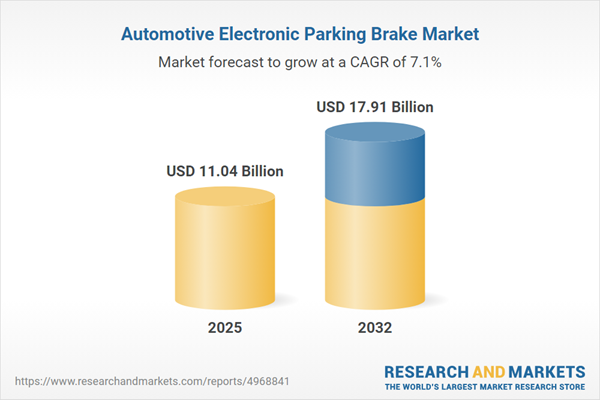Speak directly to the analyst to clarify any post sales queries you may have.
The automotive electronic parking brake market is evolving quickly, driven by technical innovation and the tightening focus on compliance across manufacturing, fleet management, and supplier segments. Senior leaders seeking growth and resilience will find this sector uniquely shaped by shifting industry requirements and dynamic operational expectations.
Market Snapshot: Automotive Electronic Parking Brake Market
The global automotive electronic parking brake market is currently valued at USD 10.31 billion, with growth predicted to reach USD 11.04 billion in the next year and a forecast expansion to USD 17.91 billion by 2032. This positive trend demonstrates how increased emphasis on safety, regulatory requirements, and advanced automotive technologies is transforming the sector. Organizations are upgrading product portfolios through focused innovation and collaborations, ensuring adaptability to emerging vehicle architectures and compliance mandates. Regulatory developments and fast-paced digitalization require businesses to update strategies for effective integration, maintaining relevance and competitiveness amid industry shifts.
Scope & Segmentation Analysis
- Vehicle Types: Heavy commercial vehicles, light commercial vehicles, and passenger cars each require dedicated engineering approaches. OEMs and partners align solutions to address differences in durability, performance, and operational context.
- Actuation Types: Cable-driven, electro pneumatic, and motor-driven electronic parking brakes allow tailored application across fleets. Each actuation type is calibrated for specific operational and reliability expectations in diverse environments.
- Technologies: E-caliper systems, offered in both fixed and floating formats, facilitate modular integration within legacy models and next-generation platforms alike. Adaptability supports multi-brand strategies and streamlines technology deployment.
- Component Types: Brake calipers, electronic control units, and actuators provide the core foundation. These components enable enhanced vehicle control, real-time system feedback, and predictive maintenance across vehicle categories.
- Integration Types: Both integrated and standalone electronic parking brake designs are implemented to maximize installation efficiency and lifecycle reliability. Such configurations help manage ongoing system upgrades with minimal operational disruption.
- Sales Channels: Original equipment and aftermarket distribution frameworks provide flexibility in inventory management. They support varying customer and market needs, allowing organizations to adapt product offerings regionally.
- End Users: Fleet operators focus on maximizing uptime and robust performance, while private and retail users place value on intuitive controls and user-friendly features, steering technology prioritization differently for each group.
- Region Coverage: North America, Latin America, Europe, Middle East, Africa, and Asia-Pacific have diverse regulatory landscapes and infrastructure readiness, affecting product launch timelines and supplier strategies. These distinctions guide partnership choices and technology rollouts.
- Competitive Landscape: Market direction is shaped by the influence of leading companies such as Robert Bosch GmbH, Continental AG, ZF Friedrichshafen AG, Valeo SA, DENSO Corporation, Aisin Seiki Co., Ltd., Mando Corporation, Nissin Kogyo Co., Ltd., Brembo S.p.A., and Nidec Corporation. Their actions help set production, quality, and innovation benchmarks for the sector.
Key Takeaways for Senior Decision-Makers
- Scalable electronic parking brake architectures support streamlined project development across multiple OEM programs, enhancing agility and speed to market.
- Brake-by-wire implementations address sustainability priorities in hybrid and electric vehicle platforms, strengthening differentiation for suppliers in procurement processes.
- Partnership models between automakers and suppliers facilitate effective adaptation to evolving compliance demands and seamless integration of new technologies in mature and emerging market segments.
- Enhanced system diagnostics and remote update functionality assist operators in minimizing downtime and optimizing predictive maintenance plans for fleet longevity.
- Prioritizing user-centric interface improvements accelerates market acceptance among both fleet and individual customers, improving operational routines and customer satisfaction.
- Regionally responsive research and procurement initiatives help enterprises anticipate policy changes, quickly pivot to address market disruptions, and maintain close alignment with local regulations.
Tariff Impact & Supply Chain Strategy
- Changes in U.S. tariffs on metals and electronic components are encouraging manufacturers to favor local and regional sourcing, aiming for supply chain stability and future-proofing against volatility.
- Supplier network diversification and adoption of predictive logistics technologies help hedge against international trade disruptions, promoting reliability and resiliency through market cycles.
- Adaptive inventory strategies and optimized distribution logistics enable ongoing operational continuity and responsiveness to market and policy shifts.
Methodology & Data Sources
This report combines qualitative interviews with industry engineers and procurement specialists with robust quantitative market analysis. By using both direct industry insight and data-driven evaluation, findings remain actionable and relevant. All processes are peer reviewed to ensure accuracy and high data quality.
Why This Report Matters for Strategic Planning
- Delivers up-to-date automotive electronic parking brake market insights for enhanced technology integration, regulatory compliance, and risk reduction.
- Supports procurement and supply chain teams in building flexible sourcing strategies able to respond effectively to global changes and local requirements.
- Arms leadership with actionable knowledge to spot new opportunities in electronic braking and strengthen supplier relationships for long-term growth.
Conclusion
Executives can leverage these data-driven insights to optimize capital allocation, enhance compliance, and refine supply chain management, driving success in the evolving automotive electronic parking brake market landscape.
Additional Product Information:
- Purchase of this report includes 1 year online access with quarterly updates.
- This report can be updated on request. Please contact our Customer Experience team using the Ask a Question widget on our website.
Table of Contents
3. Executive Summary
4. Market Overview
7. Cumulative Impact of Artificial Intelligence 2025
Companies Mentioned
The companies profiled in this Automotive Electronic Parking Brake market report include:- Robert Bosch GmbH
- Continental AG
- ZF Friedrichshafen AG
- Valeo SA
- DENSO Corporation
- Aisin Seiki Co., Ltd.
- Mando Corporation
- Nissin Kogyo Co., Ltd.
- Brembo S.p.A.
- Nidec Corporation
Table Information
| Report Attribute | Details |
|---|---|
| No. of Pages | 192 |
| Published | October 2025 |
| Forecast Period | 2025 - 2032 |
| Estimated Market Value ( USD | $ 11.04 Billion |
| Forecasted Market Value ( USD | $ 17.91 Billion |
| Compound Annual Growth Rate | 7.1% |
| Regions Covered | Global |
| No. of Companies Mentioned | 11 |









